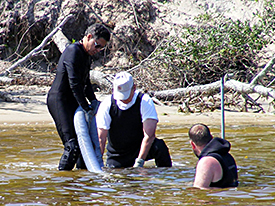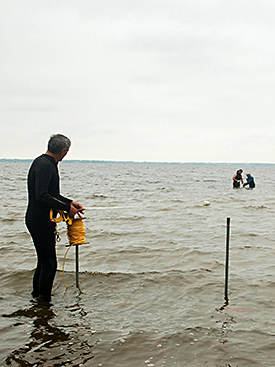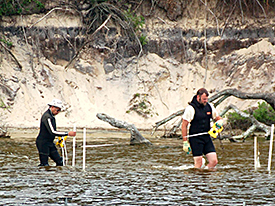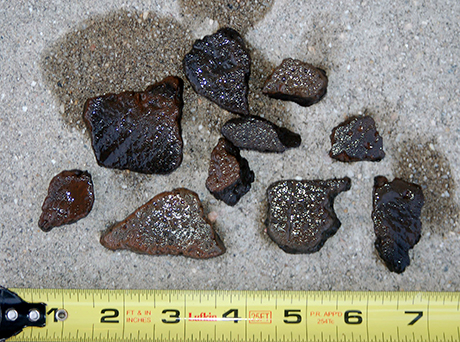
Institute for International Maritime Research, Inc:
Raleigh Colony Investigation Update 2010
By Bill Utley

Ray Hayes, Bill Utley, and Josh Daniel prepare to use the suction dredge.
The Institute for International Maritime Research, Inc (IIMR), working for the First Colony Foundation, and under the direction of Dr. Gordon Watts, assisted by Josh Daniel, Dr. Ray Hayes, and Bill Utley, conducted Part 1 of the 2010 continuing survey searching for the Lost Colony of 1587. The survey was conducted with the cooperation of the National Park Service. The work, which lasted from 16 to 22 May, consisted of sand lift operations testing a shallow area off the northeast end of Roanoke Island, NC.

Dr. Gordon Watts, Josh Daniel, and Ray Hayes at the barrel Well Site.
The area, known locally as “barrel beach”, is an area in National Park Service waters adjoining Fort Raleigh Park land. It was in the area in the 1990s that the remains of two barrel wells were found just off a small sand beach in very shallow water. Barrel wells were a common land feature, particularly in new settlements, but anywhere water was needed and not readily visible. It simply meant that wells were dug and barrels, or their equivalent (even a large hollwed tree could be used), were used to line the hole as it got deeper - in place of later bricks and stone in more settled areas. It was also in this area that an axe head was found dating back to the end of the 16th century.
Wind conditions plagued the first three days of the effort. Since the area is so shallow, relatively calm conditions were needed to position the support boat, which had to anchor just off a submerged anti-erosion barrier. The boat was needed to deploy and run the sand lift, and the water depth was just under 4 feet at the anchor spot.
During four days of work, the team laid out a lane 100 feet long by 5 feet wide from just off shore, through and past the area where the first barrel well was recovered. Another lane was laid perpendicular to the main lane through the area of the recovered barrel well for a distance of ten feet on either side. Both lanes were recorded by GPS. Additionally, the entire beach front was recorded by GPS for future reference regarding erosion or deposition. A ten-foot water probe was also used to test the depth of the sand. The probe easily penetrated to its extreme length without resistance, evidence of a very thick sand layer.

Ray Hayes and Josh Daniel measuring features at the site.
Sand lifted during the excavation was filtered through a screen that was constantly monitored by team members. Nothing significant was found for the first 45 feet of the excavation, but in and around the 45 to 55 foot area, a significant number of prehistoric pottery sherds were recovered. This seemed to be associated with tree roots. In the original photographs taken of the area in the 1990s, a submerged tree is seen in the area of the barrel well find. The effort also turned up a few 19th century sherds as well as a portion of an 18th century pipe bowl. No artifacts were recovered that could be associated with the Lost Colony, although the pre-historic sherds were from the same generic period as the Colony.
The team is planning to return to the area for another week in early September to excavate around the area of the second barrel well.

Indian Pottery Sherds found during the Barrel Beach investigation.
Return to Previous Lost Colony Post.
Return to In The Field home page.




